KIA CARENS RHD 2017 Workshop Manual
Manufacturer: KIA, Model Year: 2017, Model line: CARENS RHD, Model: KIA CARENS RHD 2017Pages: 723, PDF Size: 40.8 MB
Page 51 of 723

333
Safety features of your vehicle
The seat belt pre-tensioner system
consists mainly of the following com-
ponents. Their locations are shown in
the illustration:
1. SRS air bag warning light
2. Retractor pre-tensioner assembly
3. SRS control module
4. Emergency fastening device (EFD)*
* : if equipped
✽✽NOTICE
When the pre-tensioner seat belts are activated, a loud noise may be
heard and fine dust, which may
appear to be smoke, may be visible
in the passenger compartment.
These are normal operating condi-
tions and are not hazardous.
Although it is harmless, the fine dust may cause skin irritation and
should not be breathed for pro-
longed periods. Wash all exposed
skin areas thoroughly after an
accident in which the pre-tension-
er seat belts were activated.
Because the sensor that activates the SRS air bag is connected with
the pre-tensioner seat belt, the SRS
air bag warning light on the instru-
ment panel will illuminate for
approximately 6 seconds after the
ignition switch has been turned to
the "ON" position, and then it
should turn off.WARNING
To obtain maximum benefit
from a pre-tensioner seat belt:
1. The seatbelt must be working correctly and adjusted to the
proper position. Please read
and follow all of the important
information and precautions
about your vehicle’s occupant
safety features – including
seat belts and air bags – that
are provided in this manual.
2. Be sure you and your passen- gers always wear seat belts
properly.
ORP036066R
Page 52 of 723

Safety features of your vehicle
34
3
CAUTION
If the pre-tensioner seat belt is
not working properly, the SRS air bag warning light will illumi-nate even if there is no malfunc-tion of the SRS air bag. If theSRS air bag warning light does not illuminate when the ignitionkey is turned to ON, or if itremains illuminated after illumi- nating for approximately 6 sec-onds, or if it illuminates whilstthe vehicle is being driven, we recommend that the system beinspected by an authorised Kiadealer.
WARNING
Pre-tensioners seat belts sys- tems are designed to operate
only one time. After activation,
pre-tensioner seat belts must
be replaced. All seat belts, of
any type, should always be
replaced after they have been
worn during a collision.
The pre-tensioner seat belt assembly mechanisms become
hot during activation. Do not
touch the pre-tensioner seat
belt assemblies for several min-
utes after they have been acti-
vated.
Do not attempt to inspect or replace the pre-tensioner seat
belts yourself. We recommend
that the system be inspected by
an authorised Kia dealer.
Do not attempt to service or repair the pre-tensioner seat
belt system in any manner.
(Continued)(Continued)
Improper handling of the pre-tensioner seat belt assemblies, and failure to heed the warnings
not to strike, modify, inspect,
replace, service or repair thepre-tensioner seat belt assem-
blies may lead to improper
operation or inadvertent activa-
tion and serious injury.
Always wear the seat belts when driving or riding in a
motor vehicle.
If the vehicle or pre-tensioner seat belt must be discarded,
we recommend that you con-
tact an authorised Kia dealer.
CAUTION
Body work on the front area of
the vehicle may damage the pre-tensioner seat belt system.Therefore, we recommend that the system be serviced by anauthorised Kia dealer.
Page 53 of 723
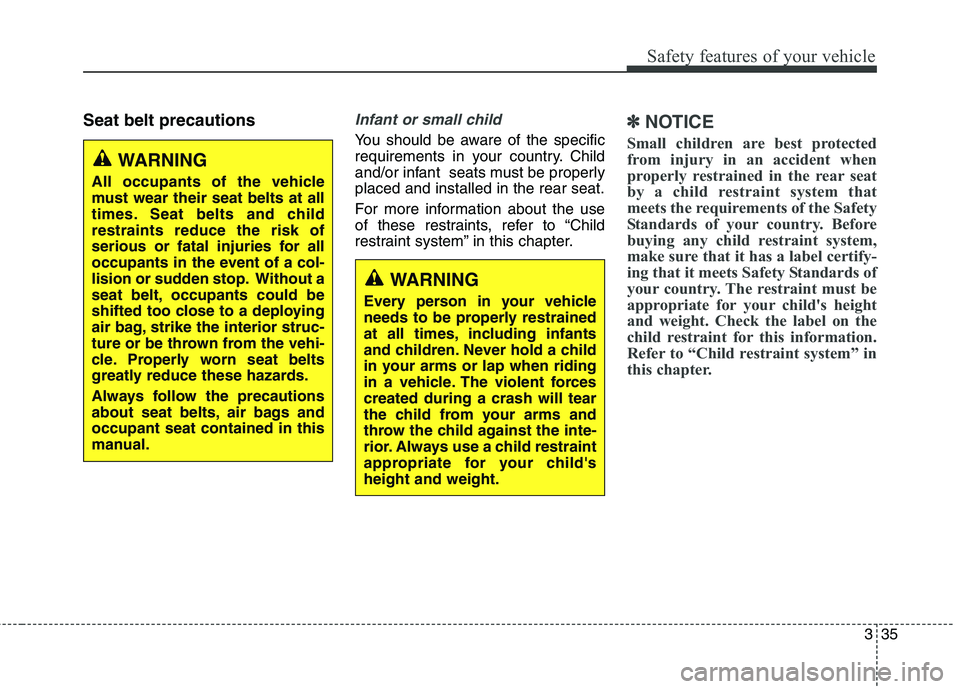
335
Safety features of your vehicle
Seat belt precautionsInfant or small child
You should be aware of the specific
requirements in your country. Child
and/or infant seats must be properlyplaced and installed in the rear seat.
For more information about the use
of these restraints, refer to “Child
restraint system” in this chapter.
✽✽NOTICE
Small children are best protected
from injury in an accident when
properly restrained in the rear seat
by a child restraint system that
meets the requirements of the Safety
Standards of your country. Before
buying any child restraint system,
make sure that it has a label certify-
ing that it meets Safety Standards of
your country. The restraint must be
appropriate for your child's height
and weight. Check the label on the
child restraint for this information.
Refer to “Child restraint system” in
this chapter.
WARNING
All occupants of the vehicle
must wear their seat belts at all
times. Seat belts and childrestraints reduce the risk of
serious or fatal injuries for all
occupants in the event of a col-
lision or sudden stop. Without a
seat belt, occupants could be
shifted too close to a deploying
air bag, strike the interior struc-
ture or be thrown from the vehi-
cle. Properly worn seat belts
greatly reduce these hazards.
Always follow the precautions
about seat belts, air bags andoccupant seat contained in this
manual.
WARNING
Every person in your vehicle
needs to be properly restrained
at all times, including infants
and children. Never hold a child
in your arms or lap when riding
in a vehicle. The violent forcescreated during a crash will tear
the child from your arms and
throw the child against the inte-
rior. Always use a child restraint
appropriate for your child'sheight and weight.
Page 54 of 723
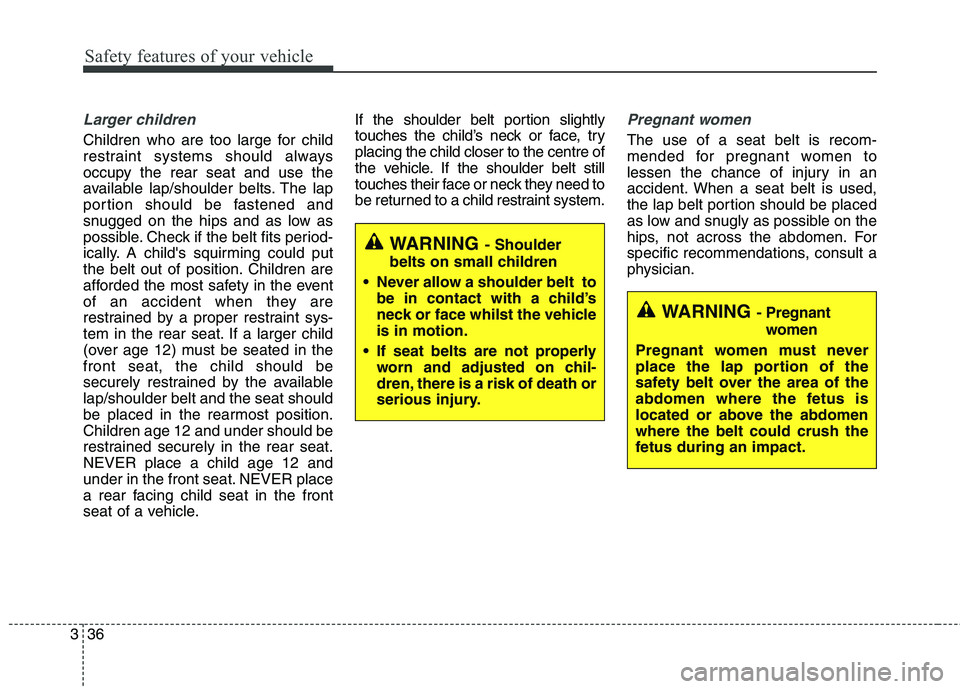
Safety features of your vehicle
36
3
Larger children
Children who are too large for child
restraint systems should always
occupy the rear seat and use the
available lap/shoulder belts. The lap
portion should be fastened and
snugged on the hips and as low as
possible. Check if the belt fits period-
ically. A child's squirming could put
the belt out of position. Children are
afforded the most safety in the event
of an accident when they are
restrained by a proper restraint sys-
tem in the rear seat. If a larger child
(over age 12) must be seated in thefront seat, the child should be
securely restrained by the availablelap/shoulder belt and the seat should
be placed in the rearmost position.Children age 12 and under should be
restrained securely in the rear seat.NEVER place a child age 12 and
under in the front seat. NEVER place
a rear facing child seat in the front
seat of a vehicle. If the shoulder belt portion slightly
touches the child’s neck or face, tryplacing the child closer to the centre of
the vehicle. If the shoulder belt still
touches their face or neck they need to
be returned to a child restraint system.
Pregnant women
The use of a seat belt is recom-
mended for pregnant women to
lessen the chance of injury in an
accident. When a seat belt is used,
the lap belt portion should be placed
as low and snugly as possible on the
hips, not across the abdomen. For
specific recommendations, consult a
physician.
WARNING
- Shoulder
belts on small children
Never allow a shoulder belt to be in contact with a child’s
neck or face whilst the vehicleis in motion.
If seat belts are not properly worn and adjusted on chil-
dren, there is a risk of death or
serious injury.
WARNING - Pregnant
women
Pregnant women must never
place the lap portion of the
safety belt over the area of the
abdomen where the fetus is
located or above the abdomenwhere the belt could crush the
fetus during an impact.
Page 55 of 723
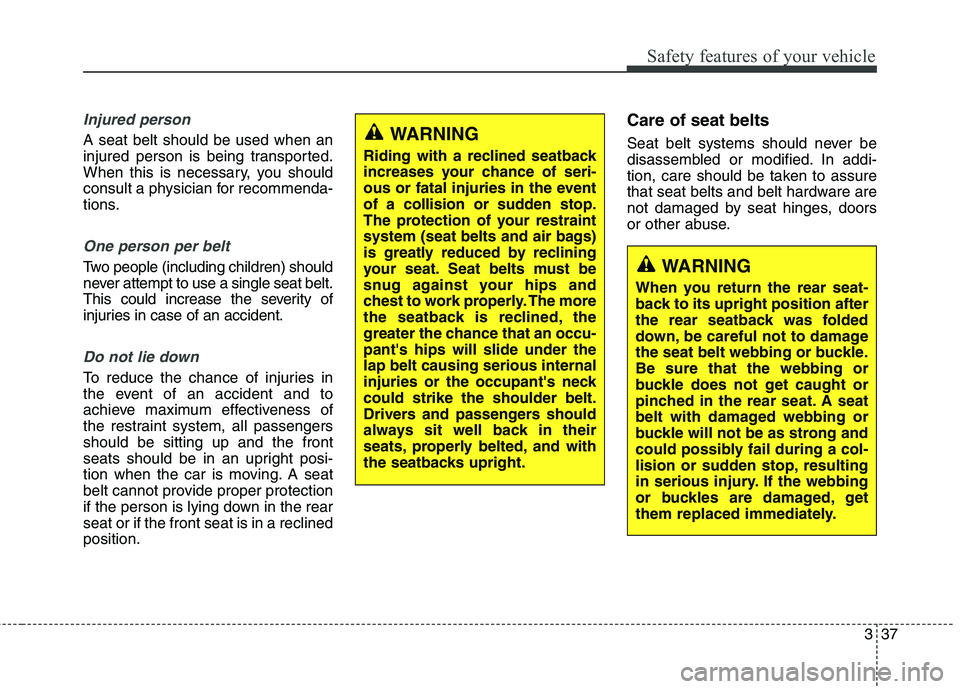
337
Safety features of your vehicle
Injured person
A seat belt should be used when an
injured person is being transported.
When this is necessary, you should
consult a physician for recommenda-
tions.
One person per belt
Two people (including children) should
never attempt to use a single seat belt.
This could increase the severity of
injuries in case of an accident.
Do not lie down
To reduce the chance of injuries in
the event of an accident and to
achieve maximum effectiveness of
the restraint system, all passengersshould be sitting up and the front
seats should be in an upright posi-
tion when the car is moving. A seat
belt cannot provide proper protection
if the person is lying down in the rearseat or if the front seat is in a reclinedposition.Care of seat belts
Seat belt systems should never be
disassembled or modified. In addi-
tion, care should be taken to assure
that seat belts and belt hardware are
not damaged by seat hinges, doors
or other abuse.
WARNING
Riding with a reclined seatback
increases your chance of seri-
ous or fatal injuries in the event
of a collision or sudden stop.
The protection of your restraint
system (seat belts and air bags)
is greatly reduced by reclining
your seat. Seat belts must be
snug against your hips and
chest to work properly. The more
the seatback is reclined, the
greater the chance that an occu-pant's hips will slide under thelap belt causing serious internal
injuries or the occupant's neckcould strike the shoulder belt.
Drivers and passengers should
always sit well back in their
seats, properly belted, and with
the seatbacks upright.
WARNING
When you return the rear seat-
back to its upright position after
the rear seatback was folded
down, be careful not to damage
the seat belt webbing or buckle.Be sure that the webbing or
buckle does not get caught or
pinched in the rear seat. A seat
belt with damaged webbing or
buckle will not be as strong and
could possibly fail during a col-
lision or sudden stop, resulting
in serious injury. If the webbing
or buckles are damaged, get
them replaced immediately.
Page 56 of 723
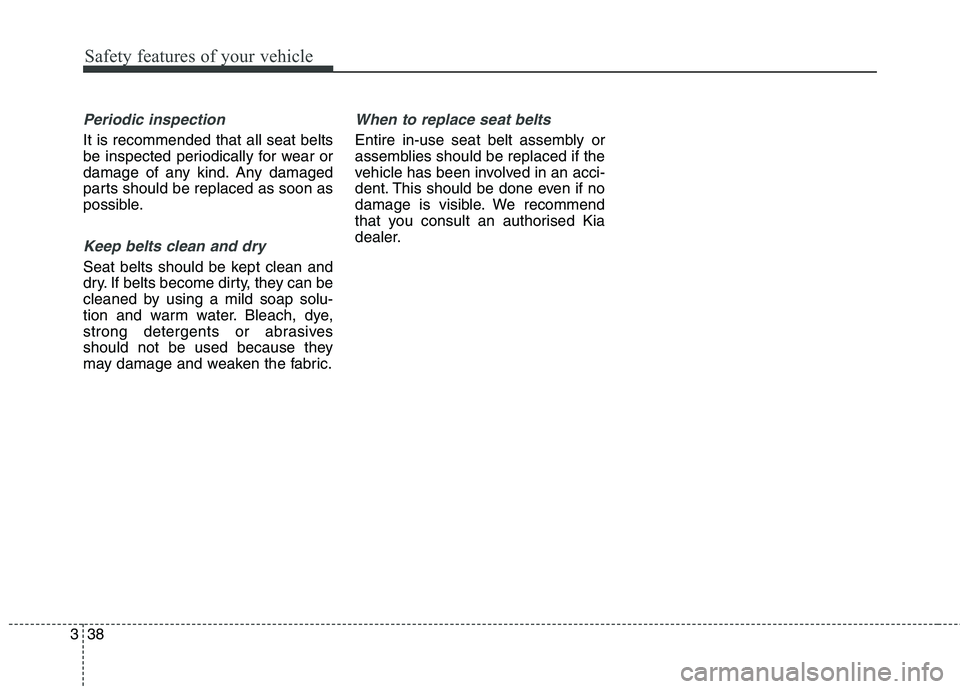
Safety features of your vehicle
38
3
Periodic inspection
It is recommended that all seat belts
be inspected periodically for wear or
damage of any kind. Any damaged
parts should be replaced as soon as
possible.
Keep belts clean and dry
Seat belts should be kept clean and
dry. If belts become dirty, they can be
cleaned by using a mild soap solu-
tion and warm water. Bleach, dye,
strong detergents or abrasives
should not be used because they
may damage and weaken the fabric.
When to replace seat belts
Entire in-use seat belt assembly or
assemblies should be replaced if the
vehicle has been involved in an acci-
dent. This should be done even if no
damage is visible. We recommend
that you consult an authorised Kia
dealer.
Page 57 of 723
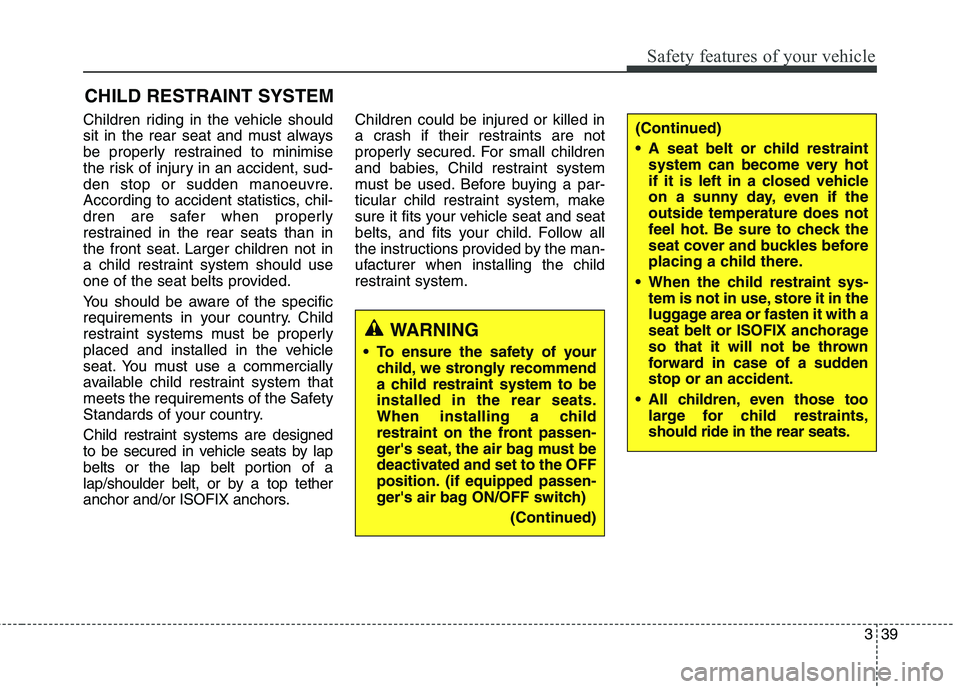
339
Safety features of your vehicle
CHILD RESTRAINT SYSTEM
Children riding in the vehicle should
sit in the rear seat and must always
be properly restrained to minimise
the risk of injury in an accident, sud-
den stop or sudden manoeuvre.
According to accident statistics, chil-
dren are safer when properly
restrained in the rear seats than in
the front seat. Larger children not in
a child restraint system should use
one of the seat belts provided.
You should be aware of the specific
requirements in your country. Child
restraint systems must be properly
placed and installed in the vehicle
seat. You must use a commercially
available child restraint system that
meets the requirements of the Safety
Standards of your country.
Child restraint systems are designed
to be secured in vehicle seats by lap
belts or the lap belt portion of a
lap/shoulder belt, or by a top tether
anchor and/or ISOFIX anchors. Children could be injured or killed in
a crash if their restraints are not
properly secured. For small children
and babies, Child restraint system
must be used. Before buying a par-
ticular child restraint system, make
sure it fits your vehicle seat and seat
belts, and fits your child. Follow all
the instructions provided by the man-
ufacturer when installing the child
restraint system.
WARNING
To ensure the safety of your child, we strongly recommend
a child restraint system to beinstalled in the rear seats.
When installing a child
restraint on the front passen-
ger's seat, the air bag must be
deactivated and set to the OFF
position. (if equipped passen-
ger's air bag ON/OFF switch)
(Continued)
(Continued)
A seat belt or child restraintsystem can become very hot
if it is left in a closed vehicle
on a sunny day, even if theoutside temperature does not
feel hot. Be sure to check the
seat cover and buckles before
placing a child there.
When the child restraint sys- tem is not in use, store it in the
luggage area or fasten it with a
seat belt or ISOFIX anchorage
so that it will not be thrown
forward in case of a suddenstop or an accident.
All children, even those too large for child restraints,should ride in the rear seats.
Page 58 of 723
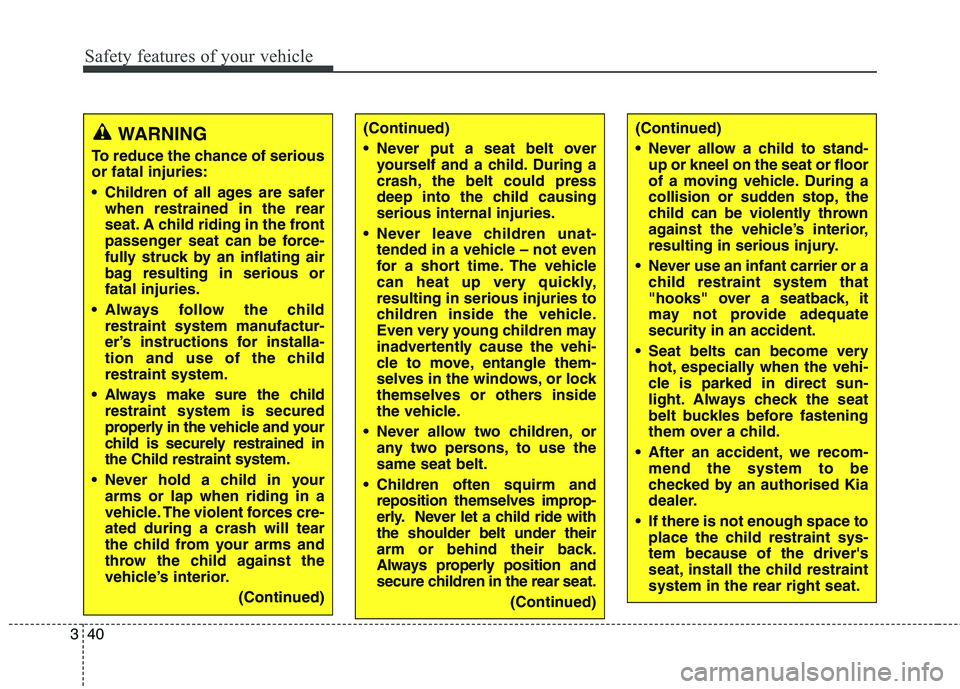
Safety features of your vehicle
40
3
WARNING
To reduce the chance of serious or fatal injuries:
Children of all ages are safer when restrained in the rear
seat. A child riding in the front
passenger seat can be force-
fully struck by an inflating air
bag resulting in serious orfatal injuries.
Always follow the child restraint system manufactur-
er’s instructions for installa-
tion and use of the childrestraint system.
Always make sure the child restraint system is secured
properly in the vehicle and your
child is securely restrained inthe Child restraint system.
Never hold a child in your arms or lap when riding in a
vehicle. The violent forces cre-ated during a crash will tear
the child from your arms and
throw the child against the
vehicle’s interior.
(Continued)(Continued)
Never put a seat belt overyourself and a child. During a
crash, the belt could press
deep into the child causingserious internal injuries.
Never leave children unat- tended in a vehicle – not even
for a short time. The vehicle
can heat up very quickly,resulting in serious injuries to
children inside the vehicle.
Even very young children may
inadvertently cause the vehi-
cle to move, entangle them-
selves in the windows, or lock
themselves or others inside
the vehicle.
Never allow two children, or any two persons, to use thesame seat belt.
Children often squirm and reposition themselves improp-
erly. Never let a child ride withthe shoulder belt under their
arm or behind their back.
Always properly position and
secure children in the rear seat.
(Continued)(Continued)
Never allow a child to stand-up or kneel on the seat or floor
of a moving vehicle. During a
collision or sudden stop, the
child can be violently thrown
against the vehicle’s interior,
resulting in serious injury.
Never use an infant carrier or a child restraint system that
"hooks" over a seatback, it
may not provide adequatesecurity in an accident.
Seat belts can become very hot, especially when the vehi-
cle is parked in direct sun-
light. Always check the seat
belt buckles before fastening
them over a child.
After an accident, we recom- mend the system to be
checked by an authorised Kia
dealer.
If there is not enough space to place the child restraint sys-tem because of the driver's
seat, install the child restraintsystem in the rear right seat.
Page 59 of 723
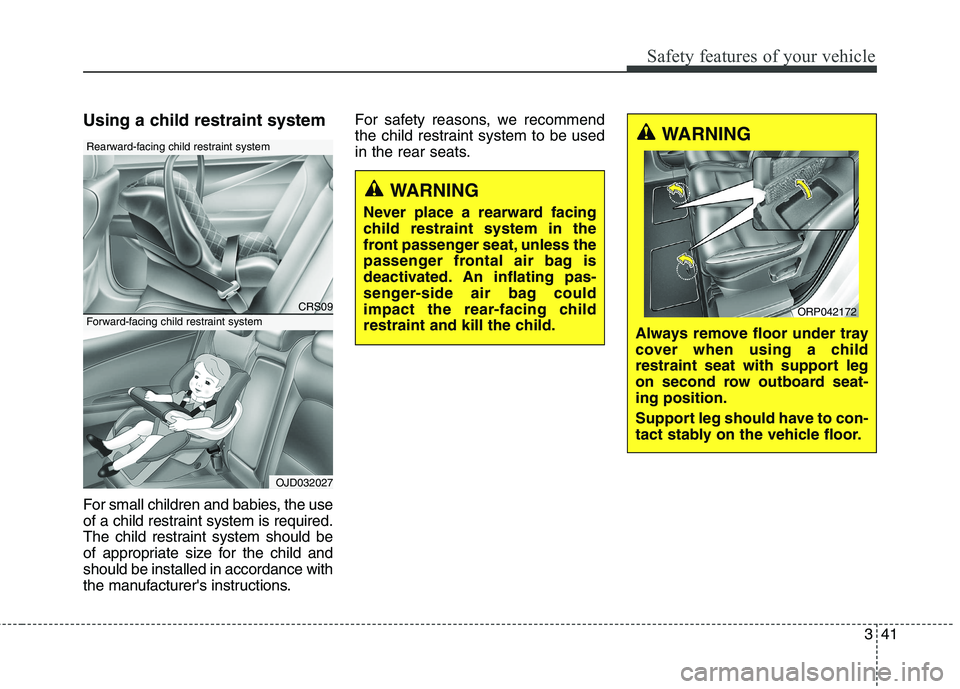
341
Safety features of your vehicle
Using a child restraint system
For small children and babies, the use
of a child restraint system is required.
The child restraint system should be
of appropriate size for the child andshould be installed in accordance with
the manufacturer's instructions.For safety reasons, we recommend
the child restraint system to be used
in the rear seats.
CRS09
OJD032027
Rearward-facing child restraint system
Forward-facing child restraint system
WARNING
Always remove floor under tray
cover when using a child
restraint seat with support leg
on second row outboard seat-ing position.
Support leg should have to con-
tact stably on the vehicle floor.
ORP042172
WARNING
Never place a rearward facing
child restraint system in the
front passenger seat, unless the
passenger frontal air bag is
deactivated. An inflating pas-
senger-side air bag could
impact the rear-facing child
restraint and kill the child.
Page 60 of 723
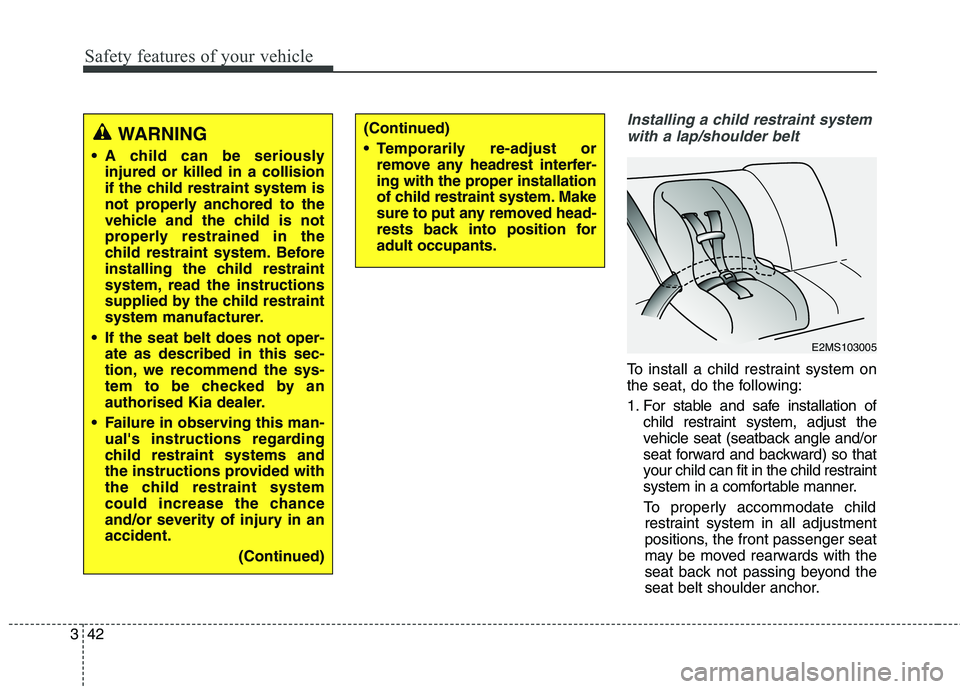
Safety features of your vehicle
42
3
Installing a child restraint system
with a lap/shoulder belt
To install a child restraint system on
the seat, do the following:
1. For stable and safe installation of child restraint system, adjust the
vehicle seat (seatback angle and/or
seat forward and backward) so that
your child can fit in the child restraint
system in a comfortable manner.
To properly accommodate child restraint system in all adjustment
positions, the front passenger seat
may be moved rearwards with the
seat back not passing beyond the
seat belt shoulder anchor.
WARNING
A child can be seriously injured or killed in a collision
if the child restraint system is
not properly anchored to the
vehicle and the child is not
properly restrained in the
child restraint system. Before
installing the child restraint
system, read the instructions
supplied by the child restraint
system manufacturer.
If the seat belt does not oper- ate as described in this sec-
tion, we recommend the sys-
tem to be checked by an
authorised Kia dealer.
Failure in observing this man- ual's instructions regarding
child restraint systems and
the instructions provided with
the child restraint system
could increase the chance
and/or severity of injury in anaccident.
(Continued)(Continued)
Temporarily re-adjust orremove any headrest interfer-
ing with the proper installation
of child restraint system. Make
sure to put any removed head-
rests back into position foradult occupants.
E2MS103005